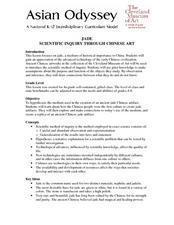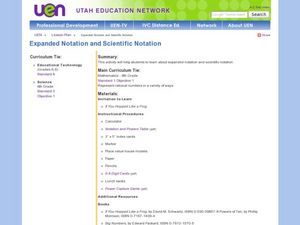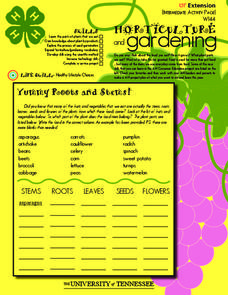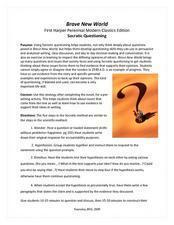Curated OER
Dinosaur and DNA Days
Biology stars extract DNA samples from beef thymus and then examine its properties. They use enzymes to digest the DNA samples, and then use electrophoresis to separate fragments. Finally, they discuss methods and principles of...
Curated OER
Exploring Learned and Innate Behavior
Students explore the differences between learned and innate behavior among humans and monkeys. They complete an assignment and read articles about two studies, which used similar test methods to show that infants and monkeys share an...
National Center for Case Study Teaching in Science
A Strange Fish Indeed
Communication is one of the most important aspects of science. In a two-day activity, your high school or college-level biologists will read excerpts from a fictional diary of Marjorie Courtenay-Latimer, the woman who discovered the...
Michigan State University
Gases Matter
Young scientists learn that seeing isn't necessarily believing when it comes to the states of matter. After performing a fun class demonstration that models the difference between solids, liquids, and gases, children complete a series of...
Virginia Department of Education
Heat and Thermal Energy Transfer
How does radiation affect our daily lives? Answer that question and others with a lesson that discusses radiation and its use in thermal energy transfer through electromagnetic waves. Pupils investigate vaporization and evaporation while...
Consortium for Ocean Leadership
Nannofossils Reveal Seafloor Spreading Truth
Spread the word about seafloor spreading! Junior geologists prove Albert Wegener right in an activity that combines data analysis and deep ocean exploration. Learners analyze and graph fossil sample data taken from sites along the...
Curated OER
Silk: Scientific Inquiry Through Chinese Art
Students investigate the many uses of silk in Chinese society through in-class experiments, group projects, and hands-on learning in this cross-curricular lesson. There are four main activities included in this lesson.
Curated OER
Jade: Scientific Inquiry Through Chinese Art
Students discover the uses of Jade in Chinese art and society through in-class discussions, group projects, and internet research. Additional enrichment activities are included.
Curated OER
Represent Rational Numbers
Pupils identify expanded notation and scientific notation. In this rational numbers instructional activity, students use a calculator to discover the powers of 10. Pupils practice writing numbers in expanded notation using powers of 10....
Curated OER
Questions About Rivers
Students investigate rivers. In this geography lesson, students work in cooperative groups to read about rivers from articles they have collected. Students form questions using Bloom's Taxonomy as a guide.
Curated OER
20th-Century Astronomy
Pupils examine and explain how the distance to nearby stars can be measured by the parallax method, discuss the role of women in the history of American astronomy, form their own opinions of the importance of Harlow Shapley and Edwin...
Curated OER
The Mystery of Christa’s Big Bubble
Students study effervescence. In this hands-on science lesson, students apply the scientific method as they complete an activity regarding the presence of bubbles in liquids.
Curated OER
Water and the Water Cycle
Pupils explore the water cycle. In this water lesson, students apply the scientific method in activities that enable them to take note of the properties of water. Pupils record how water acts on different surfaces and share their findings.
Curated OER
Horticulture and Gardening
In this colorful packet, students engage in a variety of activities involving plants and seeds. After answering the 50 questions in the packet, learners can go on to delve into their own projects.
Curated OER
4-H Horticulture and Gardening- Intermediate Learner's Page
In this 4-H horticulture and gardening worksheet, students study how some of the food they eat is the stems, roots, leaves, seeds, and flowers of plants by completing a fill-in-the-blank activity and a word search page. They examine the...
Curated OER
Build Your Own Hovercraft
Students construct a hovercraft following specific procedures. In this technology lesson, students explain the physics principles behind hovercraft. They compare and contrast this machine with the aircraft.
Curated OER
How Do Cells Reproduce?
Pupils examine cell division and the process of mitosis. In this cell reproduction lesson students grow yeast and observe the results, and learn about the career of scientific illustration.
Curated OER
Gravity Versus the Mighty Egg
Students design, revise and construct a method for protecting an egg from cracking when it is dropped from a height. They work in small groups to develop their protection method and then collect and analyze data as a class when each...
Curated OER
Dinosaur Eggs Discovered! Unscrambling the Clues
Just a heads up: this lesson is based on a book, Dinosaur Eggs Discovered! Unscrambling the Clues. If you do not have or do not want to purchase the book, you may still find the other activities and worksheets useful in your earth...
Curated OER
"Lucky Charms": Interpreting Data and Making Predictions
Seventh graders determine if a "lucky charm" will increase their chances of winning a game. Students calculate the experimental probability of each player in a game. They observe and collect data from each activity. Students compare the...
Curated OER
Socratic Questioning
If you are new to the technique of Socratic questioning, check out this resource that details the five steps in the Socratic method. The examples of each step are drawn from Brave New World.
Teach Engineering
Solenoids
Metal slinkies, coils of wire, magnetic fields, and MRIs. To determine the safety hazards of MRI machines, class members use the provided formula to calculate the magnetic field along the axis of the solenoid.
Curated OER
Who Done It?
Pick and choose which activities to include in this crime scene investigation. Junior detectives can examine fingerprints, DNA, blood samples, or bone structure. The plan suggests you have teams solve a mystery, but it does not give you...
Curated OER
FLY HIGH!!!
Students create their own bird study in their own schoolyard using the scientific method (see Testing a Hypothesis in Join the Project). Students do research in the library, at a local college, or on the Internet to determine the...

























